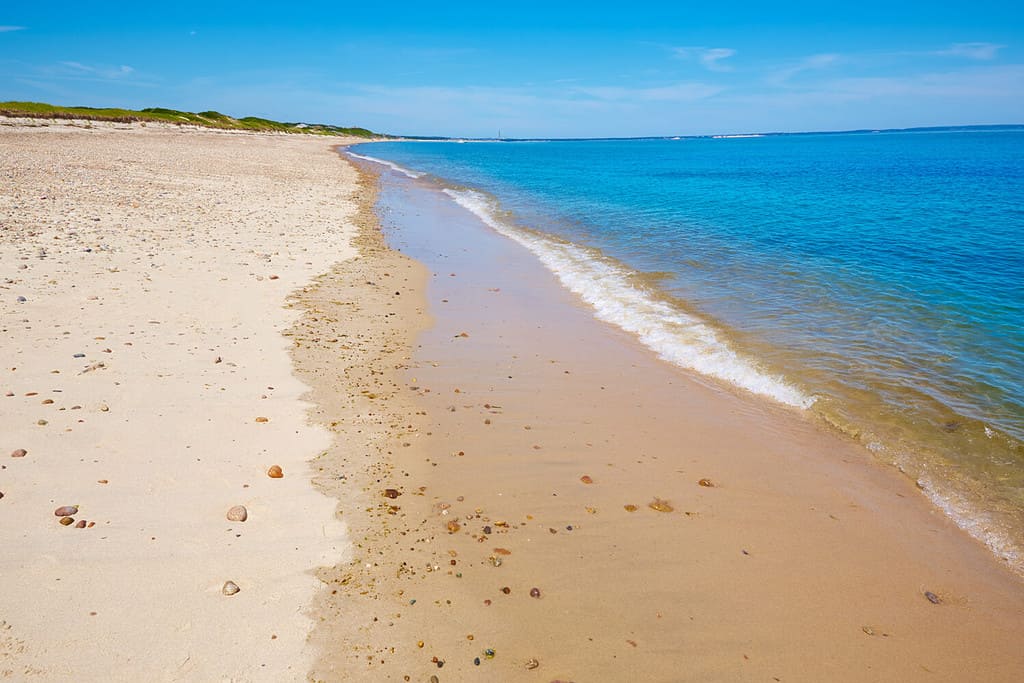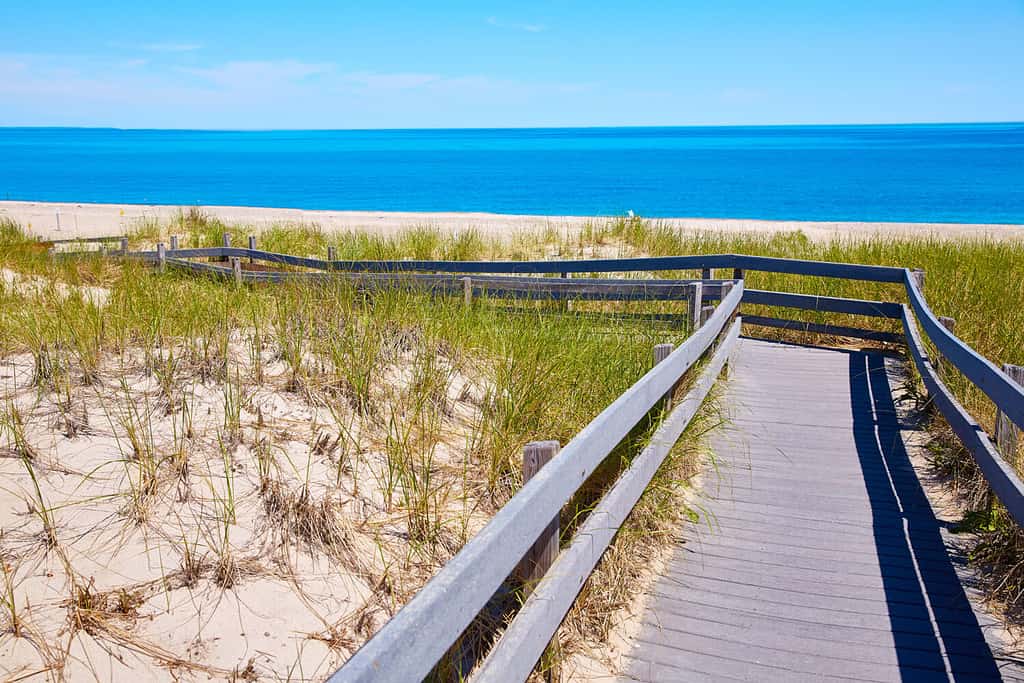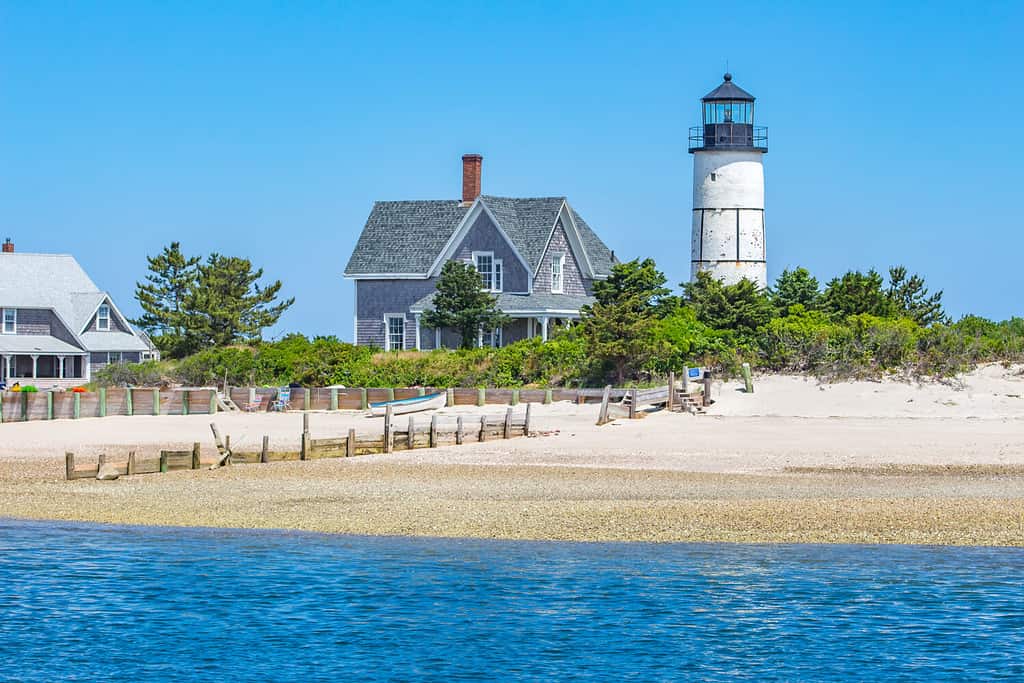Massachusetts is the seventh smallest state in the United States. Despite its small size, there are plenty of beautiful beaches where you can dip your toes in the sand and watch the waves. They all have unique features, but Sandy Neck Beach is unforgettable. Keep reading to learn why Sandy Neck Beach is six miles of perfection and what you can do while you’re here.
How Long Is Sandy Neck Beach in Massachusetts?

Sandy Neck Beach features various habitats including dunes, maritime forests, and marshes.
©lunamarina/Shutterstock.com
With six miles and 4,700 acres of dunes, maritime forests, and marshes, Sandy Neck is one of the longest beaches in Massachusetts. You can visit this beautiful stretch of sea and land in Barnstable, Cape Cod, the largest town on the peninsula. Sandy Neck Beach is recognized as a Cultural Historic District because of the many dated cottages and the Sandy Neck Lighthouse that dot the shoreline. Visitors can explore the beach by walking along the shore, swimming in the blue water, or hiking the trails that line the coast.
The History of Sandy Neck Beach

The coast of Sandy Neck Beach was a hub for fishing, whaling, and coastal trade in the 1800s.
©lunamarina/Shutterstock.com
Sandy Neck Beach is one of the longest beaches in Massachusetts and one of the most popular family spots in Cape Cod. The high, historic sand dunes and the cool, clear water make it the perfect spot for those looking to unwind from the city.
Sandy Neck’s history goes back to the early 1700s. The whole beach was open to the public then, but areas slowly became privately owned. By the mid-1800s, the Sandy Neck Lighthouse was constructed. The cottages and shacks followed suit in the late 19th century. Many of these buildings are over a century old, relics from when Barnstable was an essential port for fishing, whaling, and coastal trade. There are even rumors that runners stored liquor in the cottages during Prohibition.
Now, the lighthouse is private property and no longer used. You can’t visit the lighthouse or the privately owned cottages, but you can see them across the water from the shore or by boat. You also have the remaining perfect landscape to explore.
Plants Around Sandy Neck Beach

Native and non-native plant species are scattered all over Sandy Neck Beach.
©Kelley Campanile/Shutterstock.com
Plants native to one of the longest beaches in Massachusetts have lived on the shore for centuries. In fact, they naturally adapted to the unique coastal habitat that experiences extreme conditions, including wind, waves, storm flooding, salt spray, and drought. However, there are also non-native, invasive species of plants competing for space on the shore, consequently disrupting the fragile ecosystem.
Upper Beach
Some common native plants on the upper beach are the leafy and perennial beachgrass found along the beach and dunes. They help stabilize the beach sand and grow among other pioneer species on the backshore. Other plants growing in this part of Sandy Neck Beach are purple beach plum, lavender sea rocket, seaside goldenrod, and poison ivy. But if you do some beachcombing, you can find eelgrass, seaweed, and marine algae. You can also find different types of shells and eggs, driftwood, or even the remains of a forgotten shipwreck in the sand.
Dunes
Salt spray rose, bearberry, and bayberry grows in the primary dunes. Then, traveling into the interdune swale, which consists of higher dune systems, are plants more adapted to an arid environment. Here, the temperature is warmer, and the wind is almost non-existent.
Many birds live among the plants that grow in the secondary dunes, where the shore has been most affected by humans. These plants include cattails, reed grass, and the beginning of the thicket zone where Virginia creeper and honeysuckle grow.
Great Marsh
Last but not least is the Barnstable Great Marsh, a rich habitat on Cape Cod. The most prominent species in this section are the matted, low salt meadow cordgrass and the smooth cordgrass. There are also a variety of other grasses, such as reed grass and glasswort.
Along the trail in the maritime forest are various tree species, including sassafras, scrub oak, smooth sumac, shadbush, red cedar, and black cherry. Be careful to stay on the designated paths to prevent disturbing the ecosystem and stepping into poison ivy.
Animals Around Sandy Neck Beach

The piping plover is one of the threatened shorebirds living on Sandy Neck Beach.
©Randy G. Lubischer/Shutterstock.com
Sandy Neck Beach is made up of dunes and coastal thicket that protects the animals that live along the beautiful six-mile barrier beach. In fact, it serves as a nesting ground for many migrating shorebirds, including the threatened piping p. The salt marsh and dunes are also a nesting and feeding ground for the diamondback terrapin. Other rare species that call one of the longest beaches in Massachusetts home are the least tern and eastern spadefoot toad, but you can spot many animals along the shore.
Upper Beach
The upper beach is the most dynamic habitat along Sandy Neck Beach. In the sand, you can find clams, worms, and microscopic animals that live close to the tide. Here, shorebirds like the piping plover, lay their eggs and search for food. Gulls and terns also roam here.
Dunes
Many birds living along one of the longest beach in Massachusetts take up residence in the interdune swale. The northern harrier, mockingbirds, song sparrows, catbirds, and chickadees are only a few species living and flying among the shrubs.
Only a few animals live in the primary dunes of Sandy Neck Beach. But gulls, crows, and the occasional snowy owl stop here to rest. Don’t forget to look for tracks because raccoons, foxes, coyotes, and deer also occasionally pass through the dunes. Nevertheless, you’re more likely to see small animals like moles, mice, and shrews in the primary dunes.
Great Marsh
If you’re lucky, you may spot one of the few reptiles on Sandy Neck Beach along the salt marsh. This is where the diamondback terrapin, box turtles, hognose snakes, and garter snakes live. Many songbirds also live along the salt marsh trail and the dunes. A few species include tree swallows, common grackles, pine warblers, goldfinches, and blue jays. You can also find ospreys, blue herons, and snowy egrets fishing in the marshes.
Things to Do Near Sandy Neck Beach

The Sandy Neck Lighthouse was decommissioned in 1931 but is still a popular sight on the shore.
©njwalter2004/Shutterstock.com
Sandy Neck Beach is packed with shells and sea glass, making it feel more gravelly than soft and sandy. So, you may need to search a little harder for a nice spot to lie down in the sun. However, there are many activities for those visiting one of the longest beaches in Massachusetts. The waves are relatively short, so small children can safely play in the water with adult supervision. But beware of deep spots. You can also go off-roading, horseback riding, camping, or walk along the trails in designated areas.
Want to venture up and down the coast? Below are some popular things to do near Sandy Neck Beach.
Sandy Neck Lighthouse
The Sandy Neck Lighthouse was built in 1857 at the end of the cottage colony along the shore. It was decommissioned in 1931 because Barnstable Harbor was no longer frequently used, and the shifting sand pushed it further into the outer coast. The land is private, and no trails will lead you close to the lighthouse, so the best way to get a good look at it is from the harbor across the water, Millway Beach, or Bone Hill Beach.
Sandwich Glass Museum
If you enjoy the beauty of glassmaking, stop in to tour the Sandwich Glass Museum. They offer extensive and classic exhibits to bring the stories of glassmaking to life. These displays document and preserve the history of the town of Sandwich, the oldest town in Cape Cod, and its impact on American glass production.
Heritage Museums & Gardens
Stroll through 100 acres of specially designed gardens and stunning lawns at the Heritage Museums & Gardens. Some of the featured gardens are the Dexter Rhododendron Garden, Herb Garden, and the Cape Cod Hydrangea Display Garden. Their museum also includes 18,000 items to celebrate the rich history of Cape Cod. The museum opened in 1969 as a personal collection of antique automobiles but grew into a depiction of life in southeastern New England.
Cape Cod Museum of Natural History
The Cape Cod Museum of Natural History was founded in 1954 to preserve and educate individuals on the natural environment. The 80-acre site contains a 17,000-square-foot museum and conservation-owned land. Two floors of exhibits explain the coastal changes that have taken place around Cape Cod and display important natural artifacts.
The photo featured at the top of this post is © 162 Media Productions/Shutterstock.com
Thank you for reading! Have some feedback for us? Contact the AZ Animals editorial team.







